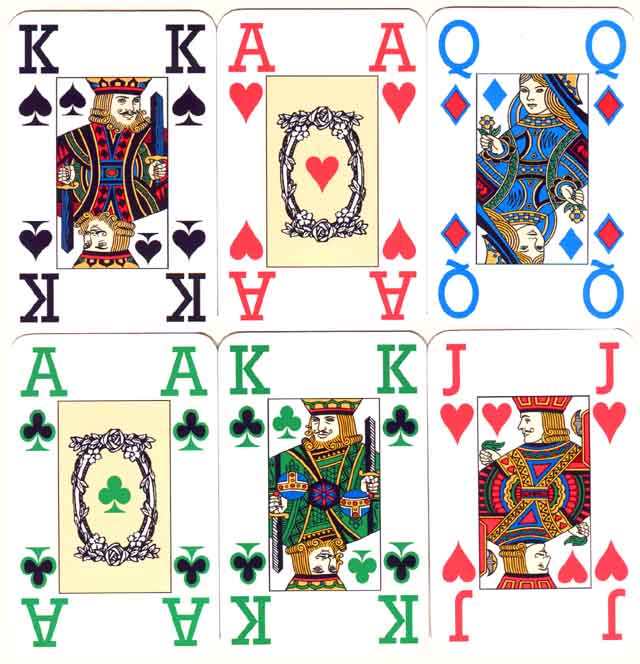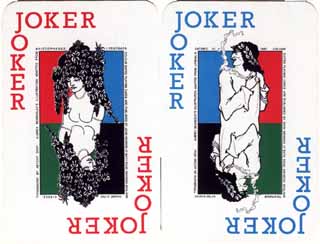John Newman’s Colour Cards
John Newman’s Colour Cards

Above: Six of John Newman's Colour cards for playing Bridge. In this new edition, colour borders have been added to the Diamond and Club suit signs to achieve greater clarity. The four Aces are decorated. The cards were designed by Anthony Gray and were printed by Richard Edward Ltd, London. An innovative feature is the use of a different colour for each suit, as opposed to the traditional red and black.
John Newman’s Colour Suited playing cards were developed for playing Bridge. The colour coding enables the player more easily to sort his hand and follow suit since in addition the indexes are much larger than normal. This means that the cards are also particularly well suited to the needs of the visually impaired, and for children or beginners.
Note: different coloured suit symbols had been patented in USA on Nov 23, 1926, by Antoine Lefebure of San Francisco, with the assertion that “even experienced players confuse clubs and spades; hearts and diamonds” here►
Other features are: both male and female double headed jokers (as far as we know for the first time) based on well known Aubrey Beardsley images - see below - and ornamented aces. The new colour cards have been used to publicise a simplified form of Bridge for children known as Mini-Bridge.
 |
"New easy-to-read four-colour playing cards are very popular" - David Bird, Bridge Columnist, Mail on Sunday. "The Bridge success story of 1995 has to be colour suited playing cards launched earlier this year by John Newman." - Bridge Christmas 95. "A step forward" - BBC Radio 4 In Touch.  |
Above: the jokers are adaptations of designs by Aubrey Beardsley, Lysistrata from Aristophanes and Satires from Juvenal's "Satire VI". |

By Simon Wintle
Member since February 01, 1996
I am the founder of The World of Playing Cards (est. 1996), a website dedicated to the history, artistry and cultural significance of playing cards and tarot. Over the years I have researched various areas of the subject, acquired and traded collections and contributed as a committee member of the IPCS and graphics editor of The Playing-Card journal. Having lived in Chile, England, Wales, and now Spain, these experiences have shaped my work and passion for playing cards. Amongst my achievements is producing a limited-edition replica of a 17th-century English pack using woodblocks and stencils—a labour of love. Today, the World of Playing Cards is a global collaborative project, with my son Adam serving as the technical driving force behind its development. His innovative efforts have helped shape the site into the thriving hub it is today. You are warmly invited to become a contributor and share your enthusiasm.
Related Articles

Boddingtons Bitter playing cards
Cool-looking courts advertising Boddingtons Bitter, originally brewed in Manchester.

OXO Faces of the Millennium Dinner
Twentieth-century personalities promoting a millennium dinner at the Oxo Tower in London.

Kids Fun Box playing cards
Colourful cards for children with four non-standard suits connected with the natural world.

Tangle Foot Ale
Badger Brewery Tangle Foot strong ale advertising pack.

Scientific Whist
“Scientific Whist” : standard cards with instructions for play on the faces by Chas Goodall & Son, 1...

Agent Provocateur
Branded lingerie collection in a pack of pin-up playing cards.

Nimbus playing cards
Mike Steer’s weather-themed pack with suits in four colours and backs for cardistry.

Agatha Christie and Playing Cards revisited
Agatha Christie uses card-play as a primary focus of a story, and as a way of creating plots and mot...

The Decadent Deck
Studies in the eroticism of the female body by Inge Clayton.

Historic Shakespeare
“Historic Shakespeare” playing cards featuring Shakespearean characters by Chas Goodall & Son.

Copechat Paramount Sorting System
Preserving the past: a specimen deck showcasing edge-notched cards and their ingenious sorting syste...

Heartsette by Herbert Fitch & Co, 1893
A glimpse into a busy print and design office in late Victorian London.

Batman® playing cards
Batman playing cards published by InterCol of London 1989.

Can You Believe Your Eyes?
“Can You Believe Your Eyes?” playing cards featuring visual illusions & other oddities.

Pastime Playing Cards for the Blind
The “Pastime” Playing Cards for the Blind manufactured by Goodall & Son Limd., c.1910.

Songs with Flute accompaniment
Eighteenth century English engraved cards with music for voice and flute.
Most Popular
Our top articles from the past 28 days

